

By Jay Chen
Photography by Jay Chen and James Tate.
Reprinted with permission.
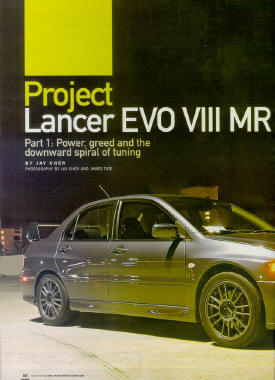 |
There's
really no excuse for how long we've kept our project EVO MR stock.
We've driven it as is for the last year, only installing a Road Race
Engineering rear anti-roll bar and R-Compound Pirelli Corsa tires in a
test bench article in January 2006. The truth is that the stock MR just
kicks ass and we're having a hard time coming to terms with changing
anything.
Normally we get behind the wheel of a project car and our heads are instantly filled wit endless ideas, ranging from the mundane to the inconceivable, on how to make it better. No such luck with the MR. There is more than enough grip, power, speed and stiffness and feel to keep the most capable driver busy. Any change would be an unnecessary compromise one way or the other. Even the change to stickier tires had our MR rolling at uncomfortable angles through corners. |
|
| But greed has a way of changing things. It was either do something with the MR or return it to Mitsubishi, so naturally we're milking it for as long as we can. Besides, how much difference can an exhaust and plumbing make? |
 |
|
INTAKE AND EXHAUSTPutting on an exhaust led us to a downward spiral of high flow cats, down-pipes, intakes, blowoff valves, boost controllers, a new fuel pump and of course, tuning. It only makes sense to do it all at once, since half these parts are bolted together anyway. Besides, what's the point of putting on a high-flow exhaust when the flow restriction upstream hasn't changed? We went to Road Race Engineering (RRE) for this round of bolt-ons because they offer some of the simplest and most cost effective solutions for going faster in an EVO. Even though the MR costs 35 large, we wanted to keep parts costs down, since the same hardware works just as well on the stripped-down RS model. That's why we used a stainless steel Espelier JGTC 500 80mm exhaust, RRE exclusive/Magnaflow high-flow cat and an Espelier 70mm downpipe instead of more costly Titanium pieces. All this takes over 11 pounds off the car. And no, we haven't gone soft because we're using a 70mm downpipe. The Espelier pipe can flow up to 600 hp and clears the active-center differential on the MR and later cars. On the intake side, the quiet stock air box was replaced with an AEM short-ram intake recalculating GReddy Type-S BOV. All this makes for a lot of unnecessarily loud racer-esque sucking and blowing, but it is something we have to deal with. The easiest way to install the intake assembly is to temporarily remove the electric radiator fan out of the way for more tool clearance. It takes some maneuvering and contortionism to get the intake parts to line up with the stock piping, so we started the Type-S BOV with RRE's EVO specific adapter. Even though we didn't' really need this part for the boost we're making at this time, it directly attached to the intake, allowing us to avoid a repeat installation. For the price, the Type-S BOV is the best BOV that can be adjusted to hold different levels of boost pressure and give us smooth blow-off transition. The Type-S BOV has a secondary boost fitting on the positive side of the valve diaphragm, which helps the valve open when the throttle closes. The assist port allows for smoother boost-to-vacuum transition part throttle driving. Backing off the valve spring tension also eases the transition so there is at least room for some part-throttle modulation. |
||
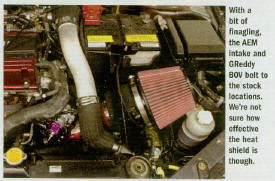 |
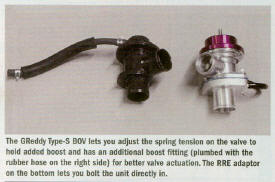 |
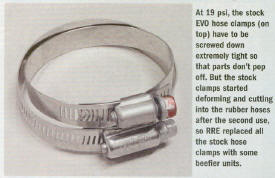 |
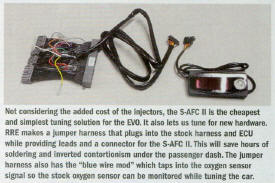
|
CAVEMAN ENGINE MANAGEMENTThe whole point of removing all these flow restrictions is to let the turbo operate more efficiently. Less pack pressure means more energy to turn the compressor wheel, which means more flow for less work. We can now take advantage of running more boost, which means more power. Like most modern cars, the MR's boost pressure is electronically regulated by the factory ECU. It's programmed to build 19 pounds of peak boost near 4,000 rpm and drop slightly as revs approach redline for safety reasons. With out reflashing ECU, the boost curve can't be changed unless we use an aftermarket boost controller. The simplest and cheapest way to change the stock boost curve is a ball and spring type manual boost controller (MBC). We chose just a unit, made by Dejon Powerhouse. It's an adjustable spring loaded check valve that stays closed until boost pressure on the other side of the ball exceeds the set spring tension, allowing us to set our boost a little higher. More importantly, the MBC gets rid of the sissy boost drop at the top where there's real power to be made. We left the stock boost control solenoid plugged into the harness to avoid triggering an engine check light. And because the EVO does not use a closed loop feedback for it's boost control, the solenoid will continue to click happily away in it's own little world with out the ECU having a clue that the wastegate isn't doing what being told. The real key to making more power on a stock turbo car is to lean out the air-fuel (A/F) mixture. Stock cars are tuned to use an excessive amount of fuel to cool the intake charge and prevent detonation. But the mixture gets so rich that combustion efficiency is sacrificed and overall power is lost. A'PEXi's S-AFC (Super Air Flow Controller) II offers an affordable and tunable temporary solution for correcting the factory fuel map without reflashing or replacing the ECU. The S-AFC splices into the factory ECU harness and intercepts the signal coming from the air flow meter, which is then corrected for the specified settings and sent to the stock ECU. By using a negative airflow correction on the S-AFC, the stock ECU is tricked into seeing less airflow going into the engine, so it injects less fuel resulting in a leaner A/F ratio and more power. Simple right? Well sort of, but the right correction factor must be entered for every 500-rpm increment, on both high and low throttle maps, without running the car so lean that it starts hitting the knock limit. RRE has an informative web site for instructions on how to street tune with the AFC on the EVO (http://www.roadraceengineering.com/newafc.htm). A leaner mixture is only half of making more power; the other half is ignition timing. For the same conservative reason the stock car runs rich, the factory ignition timing is overly retarded at full boost. To save money and avoid the need to install another piggyback, we've resorted to other tricks to fool the ECU into advancing the timing. This is why we've replaced the stock 560cc/min injectors with 660cc/min Denso units. What does injector sizing have to do with ignition timing? The ECU controls spark timing based on how much airflow it's detecting. By using larger injector, we have to further increase the airflow correction on the AFC, which makes the ECU think the engine is using even less air. The ECU will only see part -load when in reality, the the throttle is wide open and the boost is pegged at 21 psi. Since the ECU will only see part-load, it will use a more aggressive ignition timing map with more ignition advance. Voila! The ECU is kept in the dark and we have more power, As long as the correction factor isn't too lean, the car won't knock. With out the knock sensor going off, the ECU will have no idea that it's making more power than it's supposed to. |
|
TUNINGYou can't just install larger injectors and drive away. The ECU will still control the injectors as if they were stock and end up injecting a lot more fuel. We have to, at least roughly, set the AFC correction factor so that the ECU can adapt to the new lower throttle map and run. At low throttle, the ECU's closed loop operation and adaptive learning let us get away with a rough tune; just take out a couple percent and let the ECU deal with the rest. At high throttle, where all the power is made, however, there is no adaption. The only thing that will prevent the engine from blowing up is the factory knock sensor, which only pulls timing. So we have carefully set the airflow correction for a mixture that is just rich enough to make power, but not cause knock.
|
||
| After replacing the stock
fuel pump with a Walbro 255 lph unit, we tuned project MR by driving
around on the street and looking at ignition timing and oxygen sensor
activity via the OBD II port. RRE then took the MR to an AWD dyno for more
precise tuning using a wide band A/F meter. At 22 psi with coarse tuning
only, the car made 297-wheel hp, pegged at 10:1 A/F ratio. With boost
backed off to the stock peak 19 psi and with a more aggressive 12:1 A/F
ratio at the tail pipe, RRE smoothed out the power curve and made 326
wheel-hp; 80 more than stock, while on the same boost. We settled with
this compromise between a street and dyno tune. The car would have made
more power on the dyno, but the drivability would suck.
So maybe there is room for improvement on the MR after all. We're so convinced now, that we're already eagerly awaiting a new set of cams coming in the mail. |
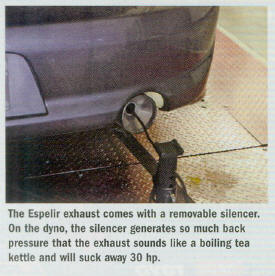 |
|
Contact Road///Race Engineering